I spent the spring of 1983 working my way through Gabriele Rico’s Writing the Natural Way: Using Right Brain Techniques to Release Your Expressive Powers. When first published by Tarcher it had a typewriter on the cover. A second edition, revised and expanded, was published in 2000. It has a computer on the cover and includes useful updates. It was a big help for me. Here are two poems that came from work with the book.
Cup
White teacup, half-full of tea,
does your close kept clay,
long held from earth,
yearn for that time when tea
could penetrate and dissolve it?
The Question
Comes an emptiness in this world,
a silent ringing,
a bright shadow,
that enters, fizzes in the blood,
boils clean the mind,
mirrors infinity,
opens me, quivering,
to ceaseless energy.
What shelter beyond this little house of bone,
soon dust?
What I beyond this question?
Gabrielle Rico’s website has loads of information and resources. She introduced the process of “clustering” which I still use. It’s also something that’s now a regular part of many writing classes.
Current Inspiration
Last July I took a one-day workshop, Poetic Medicine: The Healing Art of Poem Making, with John Fox organized by Ray McGinnis, author of Writing the Sacred: A Psalm-Inspired Path to Appreciating and Writing Sacred Poetry. Here are two poems from that day.
You’ll find good resources on both websites.
These Days
What you know keeps changing.
the sea of information floods toward you.
Learn to swim.
Loosen your hold and jump in.
Dive deep into yourself, deep into the sea,
find the pearl,
hidden by irritation,
by surface storms,
by the tumbled debris of old containers.
These days are the beginning of something new.
These days call for the pearl you’ve found.
Not Listening
Her news of chores completed, everyday encounters,
stay words; a recorded message with no response needed.
I am not listening; I am only on the phone.
I don’t hear the pleasure in her voice as she tells me about
her grandson’s request for advice,
the sadness when she mentions a call from an ill friend,
the pleasure in successfully reaching out to a new neighbor.
Her wish for my well-being isn’t felt, I am away somewhere
so unimportant I can’t remember where I’ve gone.
My heart contracts.
I realize what I’ve missed; what I’ve done.
Join the conversation: What was your early creative inspiration and what’s inspiring you now?
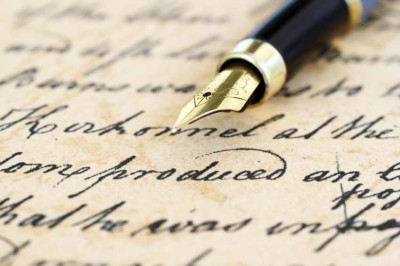
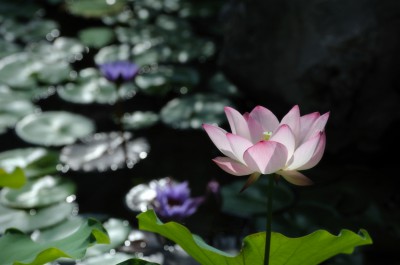

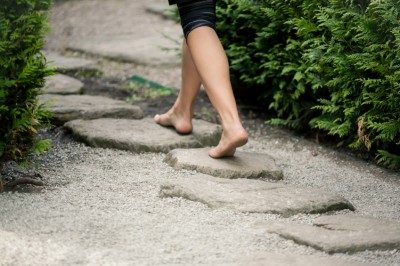
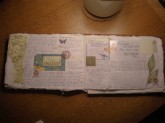 Initially I would write and then add an image or highlight a passage with color. Then, as I mentioned, I would prepare pages ahead of time so I could just fill in the blanks later with writing, but now I’ll go back and forth between the two approaches. You never want to get to a place where you‘re not writing (and I have been there) because you haven’t got a visually attractive page ready yet. I think it’s important to know that you can always go back to a page at a later date and add ‘stuff’.
Initially I would write and then add an image or highlight a passage with color. Then, as I mentioned, I would prepare pages ahead of time so I could just fill in the blanks later with writing, but now I’ll go back and forth between the two approaches. You never want to get to a place where you‘re not writing (and I have been there) because you haven’t got a visually attractive page ready yet. I think it’s important to know that you can always go back to a page at a later date and add ‘stuff’.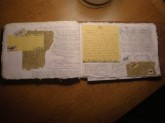 To get you thinking differently about the white page, try sectioning it off into quadrants changing the size of each ‘box’ for interest’s sake. Write in one, color one or two, draw or add images to the other. Use rubber stamps to add an individual graphic or an allover background pattern. Take several pieces of your favorite papers, rip or cut them and paste them onto the page. Embellish with rub on transfers which are still a favorite of mine and can be found at any shop that carries scrapbooking supplies.
To get you thinking differently about the white page, try sectioning it off into quadrants changing the size of each ‘box’ for interest’s sake. Write in one, color one or two, draw or add images to the other. Use rubber stamps to add an individual graphic or an allover background pattern. Take several pieces of your favorite papers, rip or cut them and paste them onto the page. Embellish with rub on transfers which are still a favorite of mine and can be found at any shop that carries scrapbooking supplies.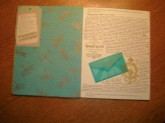 I met Joan in a course I was taking. One day she happened to bring her journal to class which was filled with quotes, drawings, and collage as well as writing and notes. Several of us were interested enough that she agreed to do a short workshop for us before the class started one day. In the workshop we learned how to make a simple book and how to work with special papers and decorative elements. I loved it and asked her to talk to me more about this type of work, Art Journaling.
I met Joan in a course I was taking. One day she happened to bring her journal to class which was filled with quotes, drawings, and collage as well as writing and notes. Several of us were interested enough that she agreed to do a short workshop for us before the class started one day. In the workshop we learned how to make a simple book and how to work with special papers and decorative elements. I loved it and asked her to talk to me more about this type of work, Art Journaling.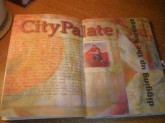 Sure, there is a really obvious turning point in my first journal, on the page and in my mind. It occurs on the fourteenth entry. I had been leaving blank spaces so I could go back and add something to the page, and realized that I didn’t enjoy working on blank white pages at all. For a lot of people the blank page is intimidating, it almost questions your ability to place anything significant on it. So I realized that by adding color or an image it instantly became more inviting and accepting to words.
Sure, there is a really obvious turning point in my first journal, on the page and in my mind. It occurs on the fourteenth entry. I had been leaving blank spaces so I could go back and add something to the page, and realized that I didn’t enjoy working on blank white pages at all. For a lot of people the blank page is intimidating, it almost questions your ability to place anything significant on it. So I realized that by adding color or an image it instantly became more inviting and accepting to words.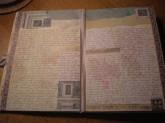 Actually, the process was working me. In the beginning I was really trying to find a form, some kind of venue for expression and that naturally evolves over time and with continued effort. You might refer to the extras that I started including on the pages as ‘visual aids’ for they guide you often into writing about something you may not have planned for that day. These entries become the happy and revealing accidents. For example a photograph of autumn leaves may inspire a memory of a childhood Thanksgiving or the photo of a recently read book jacket recalls something to mind that the author wrote that resonated with you. Even placing a quote in a ready-made box created by your use of attached images can be a jumping off point for your writing. By writing and doing ‘art’ in this manner I committed to the journal process, whether I realized it or not.
Actually, the process was working me. In the beginning I was really trying to find a form, some kind of venue for expression and that naturally evolves over time and with continued effort. You might refer to the extras that I started including on the pages as ‘visual aids’ for they guide you often into writing about something you may not have planned for that day. These entries become the happy and revealing accidents. For example a photograph of autumn leaves may inspire a memory of a childhood Thanksgiving or the photo of a recently read book jacket recalls something to mind that the author wrote that resonated with you. Even placing a quote in a ready-made box created by your use of attached images can be a jumping off point for your writing. By writing and doing ‘art’ in this manner I committed to the journal process, whether I realized it or not.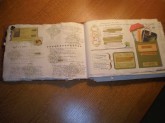 It’s the concept of the third person. When two people talk, there’s a third presence that’s added to the conversation, and an awareness that’s different. There are possibilities that open up in dialogue, whether you are dialoging with your own experience on the page, or in dialogue with another about journaling. An interesting sidebar here is that the administrative headquarters for Ira Progoff’s materials on the Intensive Journal Process is called
It’s the concept of the third person. When two people talk, there’s a third presence that’s added to the conversation, and an awareness that’s different. There are possibilities that open up in dialogue, whether you are dialoging with your own experience on the page, or in dialogue with another about journaling. An interesting sidebar here is that the administrative headquarters for Ira Progoff’s materials on the Intensive Journal Process is called 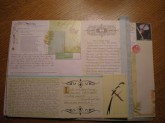 It’s been very encouraging. I go back to those journals and see the underlying need to find purpose and make sense of things in my world; I also see the uncertainty and doubts. Some of the questions and the concerns are similar to what I currently write about and I have moments where I wonder if anything has changed at all over the years. Yet it has. I am standing in a different place now. I see that person as someone who was just beginning to make a conscious choice to acknowledge an inner life as being instrumental in having an effective outer life. She was someone who didn’t yet grasp the power of keeping a journal as a form of guidance but was aware enough to want to commit to documenting her unfolding life. All lives unfold but unless you have an exceptional memory and can relive past feelings accurately, it’s difficult to pinpoint growth unless it is written somewhere. It’s like reading a letter you wrote from long ago and a memory you thought you’d lost is found. But you needed the letter to trigger the memory. Journal writing is such a trigger. They are the letters you write to yourself.
It’s been very encouraging. I go back to those journals and see the underlying need to find purpose and make sense of things in my world; I also see the uncertainty and doubts. Some of the questions and the concerns are similar to what I currently write about and I have moments where I wonder if anything has changed at all over the years. Yet it has. I am standing in a different place now. I see that person as someone who was just beginning to make a conscious choice to acknowledge an inner life as being instrumental in having an effective outer life. She was someone who didn’t yet grasp the power of keeping a journal as a form of guidance but was aware enough to want to commit to documenting her unfolding life. All lives unfold but unless you have an exceptional memory and can relive past feelings accurately, it’s difficult to pinpoint growth unless it is written somewhere. It’s like reading a letter you wrote from long ago and a memory you thought you’d lost is found. But you needed the letter to trigger the memory. Journal writing is such a trigger. They are the letters you write to yourself.
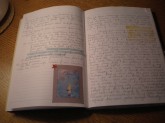
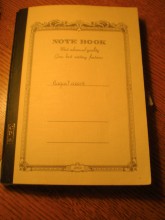 When you start it’s important to pick something for your journal that’s pleasing to you. Your words are a gift to yourself and you want to wrap them in something special. What drew me to my first journal were the black and cream graphics, the quality of the paper, and the cover, which encouragingly says, “Notebook – Most advanced quality Gives best writing features”. It reminded me of the scribblers that were handed out at the beginning of each new subject in elementary school. They too were cream and they had a maple leaf on the cover, the times table was on the back. The pages were smooth, they smelled of fresh ink. It was a real sensory experience and there was anticipation and excitement about what I would be learning. This time though the subject would be me. I wanted to treat my writing seriously; I wanted to treat my thoughts with respect.
When you start it’s important to pick something for your journal that’s pleasing to you. Your words are a gift to yourself and you want to wrap them in something special. What drew me to my first journal were the black and cream graphics, the quality of the paper, and the cover, which encouragingly says, “Notebook – Most advanced quality Gives best writing features”. It reminded me of the scribblers that were handed out at the beginning of each new subject in elementary school. They too were cream and they had a maple leaf on the cover, the times table was on the back. The pages were smooth, they smelled of fresh ink. It was a real sensory experience and there was anticipation and excitement about what I would be learning. This time though the subject would be me. I wanted to treat my writing seriously; I wanted to treat my thoughts with respect.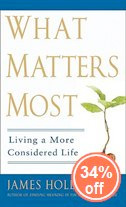
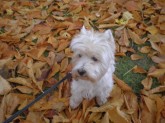 Last week when the late afternoon sun and a breeze turned the leaves, wearing their last burst of intense colour, into drifting magic, Aimee and I went for a walk. One of the things about keeping company with a dog is knowing that you will be outside at least four or five times that day, so even if you get engrossed in your work, your friend’s not going to let you forget that the world is there. This day we escaped for a longer walk. As I watched her investigate a section of leaf-covered lawn with intense interest, her nose touching the leaves and rooting for the grass underneath, the demands of the day fell away. We stood together on a carpet of gold and red leaves with the wind shaking more down around us. It was quiet, except for the breeze rustling the leaves, and the distant bark of another dog. Nothing to do but breathe, and swim in colour.
Last week when the late afternoon sun and a breeze turned the leaves, wearing their last burst of intense colour, into drifting magic, Aimee and I went for a walk. One of the things about keeping company with a dog is knowing that you will be outside at least four or five times that day, so even if you get engrossed in your work, your friend’s not going to let you forget that the world is there. This day we escaped for a longer walk. As I watched her investigate a section of leaf-covered lawn with intense interest, her nose touching the leaves and rooting for the grass underneath, the demands of the day fell away. We stood together on a carpet of gold and red leaves with the wind shaking more down around us. It was quiet, except for the breeze rustling the leaves, and the distant bark of another dog. Nothing to do but breathe, and swim in colour. Last January I became a mentor for Connect to Success, the Vancouver YWCA program that serves women who are entering or re-entering the workforce in a professional or skilled field, or who are underemployed and looking for more meaningful employment. I’ve thoroughly enjoyed the process and look forward to being a mentor again.
Last January I became a mentor for Connect to Success, the Vancouver YWCA program that serves women who are entering or re-entering the workforce in a professional or skilled field, or who are underemployed and looking for more meaningful employment. I’ve thoroughly enjoyed the process and look forward to being a mentor again.